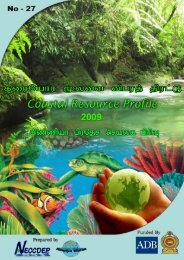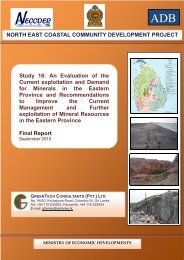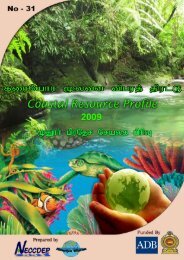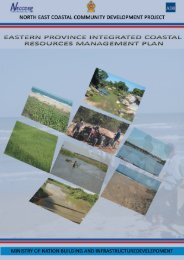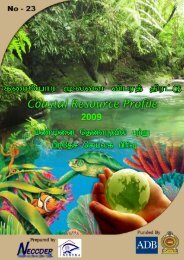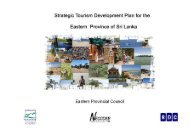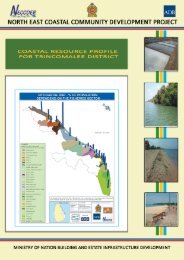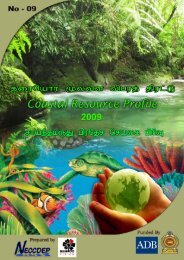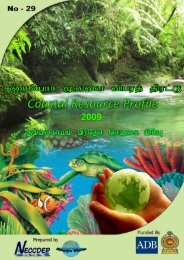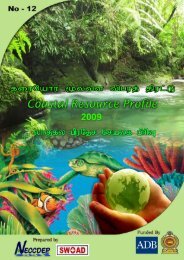Untitled - Neccdep.com
Untitled - Neccdep.com
Untitled - Neccdep.com
Create successful ePaper yourself
Turn your PDF publications into a flip-book with our unique Google optimized e-Paper software.
TRINCOMALEE BAY SPECIAL MANAGEMENT AREA Page | 32<br />
of thorns starfish (Acanthaster planci) and other invasive species can <strong>com</strong>pounded the<br />
damage to the coral reefs.<br />
138. NARA has identified many issues which threaten the sustainability of reef ecosystems<br />
in Trin<strong>com</strong>alee bay. Reefs are threatened by dynamite fishing, collection of corals for the<br />
aquarium trade, breaking of corals to obtain giant tubeworms and sea feathers for the<br />
aquarium trade, spear fishing, boat anchors, use of illegal fishing gears and tools, boat<br />
anchorage, pollution, accidental treading and breaking by tourists, and collecting as<br />
souvenirs. There are seven or eight aquarium trade <strong>com</strong>panies in Trin<strong>com</strong>alee alone, and a<br />
further four or five <strong>com</strong>panies operate out of China bay. These employ 150-200 aqualung<br />
divers plus additional 50-60 snorkelers.(Personal <strong>com</strong>munication with Arjan Rajasuriya -<br />
NARA)<br />
8. Forests and Forest Plantations<br />
139. Hilly areas in the north western section of the Trin<strong>com</strong>alee bay are covered with<br />
natural forest dominated by semi-deciduous monsoon forests. Degraded secondary scrub<br />
forests are found at lower elevations in these hilly ranges. Due to the rocky outcrops in the<br />
hilly areas, natural forests are less diverse and sparse. The natural forests are dominated by<br />
species such as Chloroxylon swietenia (satin wood), Drypetes sepiaria, and Manilkara<br />
hexandra while other species such as Bauhinia racemosa, Sterculia spp and Zizyphus spp.,<br />
are less prevalent.<br />
140. There are no forest plantations in the SAM planning area. There is no information<br />
about the extent of the forests and forest plantations in the SAM planning area. However,<br />
Trin<strong>com</strong>alee District has high forest cover and recent study by Urban Development Authority<br />
shows that forest cover of the district is 49% (130,000 hectares).<br />
9. Wild fauna<br />
141. The hilly terrain and extensive network of wetlands covering over 50,000 ha that<br />
extend inland from Trin<strong>com</strong>alee harbour / Koddiyar bay between Kinniya and Muthur create a<br />
diverse mosaic of habitat for wild fauna. Unfortunately no studies have been carried out in<br />
the hilly areas around the bay because these areas are under the control of the security<br />
forces where the Navy, Air force and Army have bases. Due to the relatively large area and<br />
diversity of habitat types, faunal diversity could also be very high. Rare fauna such as<br />
Elephant (Maximum maximum), Crocodile (Crocodylus palustris, C. Porosus) Leopard<br />
(Panthera pardus) have been reported in the SAM planning area in the past.<br />
142. The Great Sober Island and Little Sober Island in the inner harbour were declared as<br />
sanctuaries in 1963 partly to protect an elephant route where elephant swam from Snug cove<br />
to the islands. These movements were still reported to occur in 2001. This phenomenon<br />
would be of huge interest to tourists and for tourism marketing purposes. It is, therefore,<br />
important that the elephant corridors between the delta area and Snug cove are kept clear of<br />
any development and barriers removed as soon as the security situation warrants (Ref.0950).<br />
143. Avifauna diversity is <strong>com</strong>paratively high due to habitat diversity such as hilly forests,<br />
scrub forests, mangroves, mud flats and coastal water bodies. Different studies have<br />
identified 65 avifaunal species in and around Trin<strong>com</strong>alee bay. The <strong>com</strong>mon bird species are<br />
terns, gulls, pond herons and egrets. Large resident water birds have been recorded in<br />
wetlands around the bay and the bay attracts large numbers of migratory birds in the winter<br />
months.



